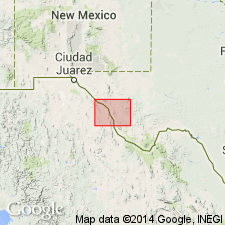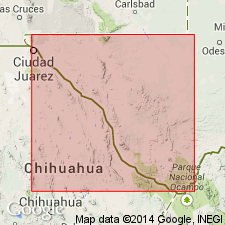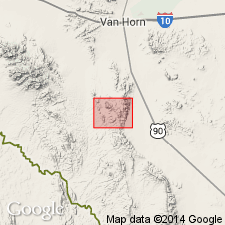
- Usage in publication:
-
- Pantera Trachyte
- Modifications:
-
- Areal extent
- Geochronologic dating
- AAPG geologic province:
-
- Permian basin
Summary:
Pantera Trachyte mapped as a formation of Garren Group in the Eagle, Van Horn, and Wylie Mountains area, Culberson and Jeff Davis Cos, west TX in Permian basin. Garren Group is shown on the Correlation of Map Units as consisting of (ascending): Hogeye Tuff, Pantera Trachyte, an undivided part, and Petan Basalt. In Eagle Mountains area Pantera is resistant, pale red or grayish red, with 6 ft of black- to light-gray welded crystal tuff at base; 45 ft thick. In Van Horn Mountains, it is light brownish gray to grayish red; about 40 ft thick. In Wylie Mountains it is hard, non-vesicular, reddish brown; thickness 100-300 ft. K-Ar ages of 32.4 +/-1.7 and 34.2 +/-3.0 m.y. obtained in two samples. [Author states that correlation of volcanic rocks from area to area on Marfa sheet is uncertain--little attempt is made to correlate between areas. The rocks are described by area.] Pantera is of Oligocene age. Geologic map.
Source: GNU records (USGS DDS-6; Denver GNULEX).

- Usage in publication:
-
- Pantera Trachyte
- Modifications:
-
- Geochronologic dating
- AAPG geologic province:
-
- Permian basin
Summary:
Pg. 11, 14. Pantera Trachyte of Vieja Group of Twiss (1959) = High Lonesome Tuff of Vieja Group of Henry and Price (1986). Rhyolite samples from the Van Horn Mountains caldera, Lobo and Lobo SW quadrangles, Brewster and Jeff Davis Counties, southwestern Texas, yielded K-Ar ages from 45.6 +/-1.3 Ma to 36.9 +/-0.8 Ma (alkali feldspar). Rhyolite samples (localities unknown) yielded K-Ar ages of 35.0 +/-3.0 Ma and 33.3 +/-1.7 Ma (alkali feldspar). Data from R.K. DeFord, 1958 (Texas Jour. Sci., v. 10, p. 1-37), and J.A. Wilson and others, 1968 (Amer. Jour. Sci., v. 266, p. 590-604); ages recalculated using decay constants of Steiger and Jager, 1977 (Earth Planet. Sci. Letters, v. 36, p. 359-362).
[Age considered Eocene to Oligocene; Eocene-Oligocene boundary 36.6 (38-34) Ma (from Geologic Names Committee, USGS, 1983 ed. geol. time scale, with additions from N.J. Snelling, 1985, The Geol. Soc. Mem., no. 10).]
Source: Publication; supplemental information from GNU records (USGS DDS-6; Denver GNULEX).

- Usage in publication:
-
- Pantera Trachyte
- Modifications:
-
- Not used
Summary:
Name restricted to the lava flows only in the Van Horn Mountains and Wylie Mountain area, Culberson Co, TX in Permian basin. The rhyolitic ash-flow tuff formerly included in Pantera placed in the newly named High Lonesome Tuff. [Reason for restriction not stated.] Not shown on geologic map. Chart shows relationship of Pantera (earlier reports) and High Lonesome (this report).
Source: GNU records (USGS DDS-6; Denver GNULEX).
For more information, please contact Nancy Stamm, Geologic Names Committee Secretary.
Asterisk (*) indicates published by U.S. Geological Survey authors.
"No current usage" (†) implies that a name has been abandoned or has fallen into disuse. Former usage and, if known, replacement name given in parentheses ( ).
Slash (/) indicates name conflicts with nomenclatural guidelines (CSN, 1933; ACSN, 1961, 1970; NACSN, 1983, 2005, 2021). May be explained within brackets ([ ]).

